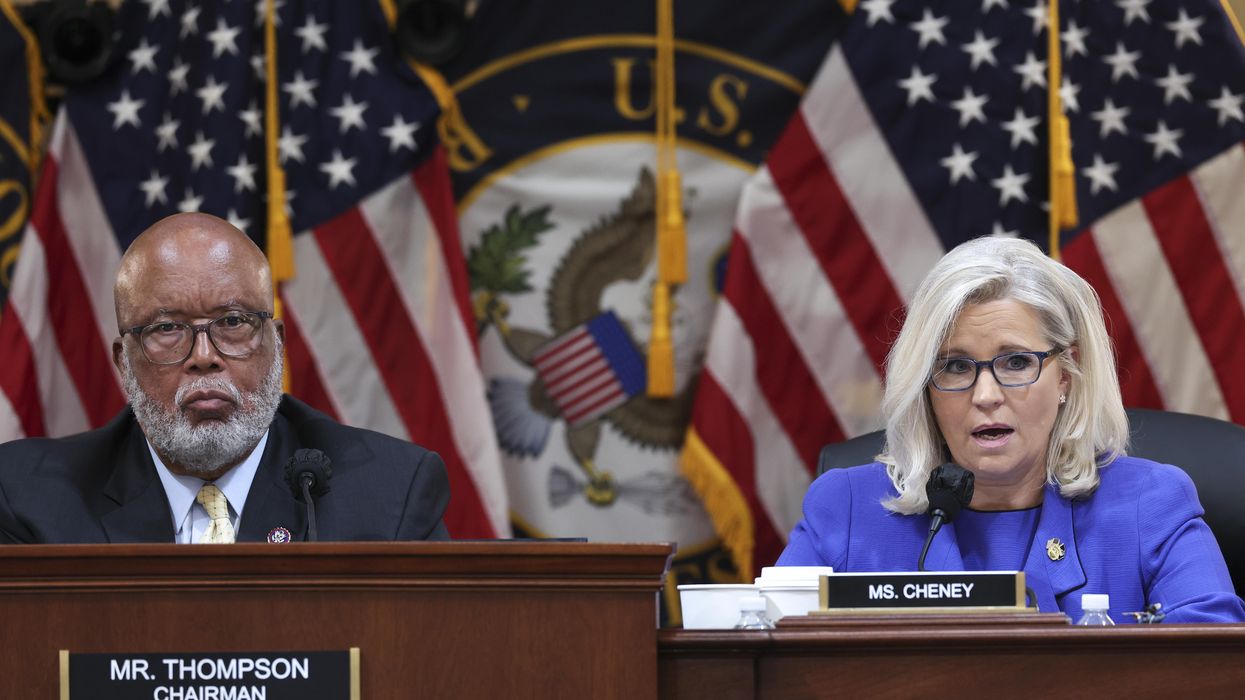The committee investigating the Jan. 6, 2021, insurrection at the Capitol conducted a riveting public hearing in prime time Thursday. Carried by most of the major broadcast and cable news networks, the two-hour proceeding featured video of the riot, recorded statements from advisers to Donald Trump and powerful testimony from a police officer injured during the attack.
Observers on the left and right found the hearing compelling, the testimony heartfelt – but not always convincing.
What follows is a selection of responses from across the political spectrum.
Peter Baker in The New York Times:
Still, there was another audience for the hearings as they got underway, and that was Attorney General Merrick B. Garland. If the committee was laying out what it considered an indictment against the former president, it seemed to be inviting the Justice Department to pursue the real kind in a grand jury and court of law.
As she previewed the story that will be told in the weeks to come, Ms. Cheney all but wrote the script for Mr. Garland. “You will hear about plots to commit seditious conspiracy on Jan. 6,” she said, “a crime defined in our laws as conspiring to overthrow, put down or destroy by force the government of the United States or to oppose by force the authority thereof.”
Liz Cheney did her job tonight. Her remarks, and the hearing as a whole, gave me confidence the Jan. 6th Committee will do its job well over the next two weeks. We all complain, often justifiably, about the failures of our leaders, the failures in particular of members of Congress. But the Jan. 6th Committee, I will venture to say, will do its job. The question is whether we the people will do our duty in drawing the conclusions we need to draw. Will we make these hearings an inflection point in strengthening our democracy, not just a blip in politics as usual?
Susan Glasser in The New Yorker:
The hearing began and ended, as it should have, with Trump himself. “President Trump summoned the mob, assembled the mob, and lit the flame of this attack,” Cheney said, consciously echoing an interview that she gave to Fox News on the afternoon of January 6th, while she and her colleagues were still in hiding from the pro-Trump mob. It said everything about where American politics are today that on Thursday night, a year and a half after the events in question, Fox News did not dare to broadcast Liz Cheney’s remarks—or to air the full hearing live, as the other networks did. Instead, it chose to run its regular evening programming of Tucker Carlson, Sean Hannity, and the rest of the Trump propaganda machine.
Brain Walsh, former communications aide for House and Senate Republicans:
\u201cAs someone who spent many years working on Capitol Hill and every day, including on 9/11, saw our USCP officers standing guard - I have tremendous respect for their service and remain outraged by what happened on January 6th as they were attacked. It should outrage everyone.\u201d— Brian Walsh (@Brian Walsh) 1654824134
Gary Abernathy in The Washington Post:
There was much focus on the actions of the militant Proud Boys and Oath Keepers. If the committee’s purpose was to convict those groups of planning and carrying out the Capitol incursion, they may have succeeded. If the goal was to prove that they were acting at Trump’s direction — even if they convinced themselves that they were through inferences and assumptions based on Trump’s random tweets — the committee failed. The sometimes convoluted efforts by Rep. Bennie G. Thompson (D-Miss.), the committee’s chairman, to connect the dots, and video editing that synced Trump’s comments with various insurrectionist acts, were ineffective.
Walter Shapiro in The New Republic:
The committee is still bipartisan, with Cheney and Representative Adam Kinzinger onboard. But these two Republicans remain the antithesis of the cult of Trump. The result: the first congressional committee in memory on which all nine members are united in the same cause—getting at the truth of the attempted coup of January 6. That meant the narrative was not interrupted by Benghazi-style grandstanding and conspiracy-mongering by scorched-earth Republicans.
Kimberly Strassel in the Wall Street Journal:
What’s actually missing in this special sauce of prime TV hours, slick videos and positive press is the one ingredient truly vital for public interest: credibility. If huge swathes of America ignore the committee’s work, it will be because the committee itself—through its construction and through its actions—made it easy.
Philip Bump in The Washington Post:
Yes, God forbid that Fox News should air an hour of propaganda or dishonesty. Carlson didn’t articulate the purported lies, which he couldn’t have, because the hearing hadn’t actually begun by that point. But it didn’t matter, because his audience wasn’t hearing the evidence from the hearing anyway. Was it a lie when the hearing showed William P. Barr, Trump’s ever-loyal attorney general, describing Trump’s voter-fraud claims as nonsense? Doesn’t matter, just wave it all away as untrustworthy without actually explaining what was said and why it couldn’t be trusted.
Debilyn Molineaux:
James Fallows:
\u201cGood for Bob Woodward:\n\n- CNN question: \u201cWell, is there anything new, that will change anyone\u2019s mind?\u201d\n\n- Woodward: \u201cThis evening was historic.\u201d \u201cIt was the equivalent of the Army-McCarthy hearings."\u201d— James Fallows (@James Fallows) 1654828856
Heather Cox Richardson:
Veteran reporter Bob Woodward called the evening “historic.” Looking back at the 1954 hearings that destroyed the career of Senator Joe McCarthy by revealing that he was lying to the American public, Woodward said that tonight’s event “was the equivalent of the Army-McCarthy hearings." (found in Heather Cox Richardson’s daily email)
Stephen Colbert:
Stephen's LIVE MONOLOGUE After The January 6th Committee Primetime Hearingwww.youtube.com





















A deep look at how "All in the Family" remains a striking mirror of American politics, class tensions, and cultural manipulation—proving its relevance decades later.
All in This American Family
There are a few shows that have aged as eerily well as All in the Family.
It’s not just that it’s still funny and has the feel not of a sit-com, but of unpretentious, working-class theatre. It’s that, decades later, it remains one of the clearest windows into the American psyche. Archie Bunker’s living room has been, as it were, a small stage on which the country has been working through the same contradictions, anxieties, and unresolved traumas that still shape our politics today. The manipulation of the working class, the pitting of neighbor against neighbor, the scapegoating of the vulnerable, the quiet cruelties baked into everyday life—all of it is still here with us. We like to reassure ourselves that we’ve progressed since the early 1970s, but watching the show now forces an unsettling recognition: The structural forces that shaped Archie’s world have barely budged. The same tactics of distraction and division deployed by elites back then are still deployed now, except more efficiently, more sleekly.
Archie himself is the perfect vessel for this continuity. He is bigoted, blustery, reactive, but he is also wounded, anxious, and constantly misled by forces above and beyond him. Norman Lear created Archie not as a monster to be hated (Lear’s genius was to make Archie lovable despite his loathsome stands), but as a man trapped by the political economy of his era: A union worker who feels his country slipping away, yet cannot see the hands that are actually moving it. His anger leaks sideways, onto immigrants, women, “hippies,” and anyone with less power than he has. The real villains—the wealthy, the connected, the manufacturers of grievance—remain safely and comfortably offscreen. That’s part of the show’s key insight: It reveals how elites thrive by making sure working people turn their frustrations against each other rather than upward.
Edith, often dismissed as naive or scatterbrained, functions as the show’s quiet moral center. Her compassion exposes the emotional void in Archie’s worldview and, in doing so, highlights the costs of the divisions that powerful interests cultivate. Meanwhile, Mike the “Meathead” represents a generation trying to break free from those divisions but often trapped in its own loud self-righteousness. Their clashes are not just family arguments but collisions between competing visions of America’s future. And those visions, tellingly, have yet to resolve themselves.
The political context of the show only sharpens its relevance. Premiering in 1971, All in the Family emerged during the Nixon years, when the “Silent Majority” strategy was weaponizing racial resentment, cultural panic, and working-class anxiety to cement power. Archie was a fictional embodiment of the very demographic Nixon sought to mobilize and manipulate. The show exposed, often bluntly, how economic insecurity was being rerouted into cultural hostility. Watching the show today, it’s impossible to miss how closely that logic mirrors the present, from right-wing media ecosystems to politicians who openly rely on stoking grievances rather than addressing root causes.
What makes the show unsettling today is that its satire feels less like a relic and more like a mirror. The demagogic impulses it spotlighted have simply found new platforms. The working-class anger it dramatized has been harvested by political operatives who, like their 1970s predecessors, depend on division to maintain power. The very cultural debates that fueled Archie’s tirades — about immigration, gender roles, race, and national identity—are still being used as tools to distract from wealth concentration and political manipulation.
If anything, the divisions are sharper now because the mechanisms of manipulation are more sophisticated, for much has been learned by The Machine. The same emotional raw material Lear mined for comedy is now algorithmically optimized for outrage. The same social fractures that played out around Archie’s kitchen table now play out on a scale he couldn’t have imagined. But the underlying dynamics haven’t changed at all.
That is why All in the Family feels so contemporary. The country Lear dissected never healed or meaningfully evolved: It simply changed wardrobe. The tensions, prejudices, and insecurities remain, not because individuals failed to grow but because the economic and political forces that thrive on division have only become more entrenched. Until we confront the political economy that kept Archie and Michael locked in an endless loop of circular bickering, the show will remain painfully relevant for another fifty years.
Ahmed Bouzid is the co-founder of The True Representation Movement.